
CHAPTER 1: Lakeview Cemetery
I don’t know why it took me so long to appreciate Lakeview Cemetery. I’ve lived in my neighborhood off and on since 1997, and sometimes it feels like I know Capitol Hill’s cracks and crevices like the veins on the backs of my own hands.
I’d known about Lakeview, of course. It’s the home of both Bruce and Brandon Lee’s graves, and it’s thought of as Seattle’s “Pioneer Cemetery” because so many of the city’s founders are buried there. In the early ‘00s, when I was living in Los Angeles and slightly homesick, I loved seeing Lakeview in the title credits of HBO’s Six Feet Under every week.
When my son was a toddler, I’d stand bleary and exhausted as he played at the Volunteer Park playground, sipping my tea and musing on the poetry of the cemetery being right next to the play area. I love that there are only a few feet and a chainlink fence separating the sounds of squealing children from the silence of the gravestones. There’s a great metaphor in there somewhere!
But it wasn’t until these past few years that Lakeview Cemetery has become a friend of mine, one of my favorite neighborhood walks.
It wasn’t until these past few years that I’ve had a quilt hanging in my living room that says WE’RE ALL GONNA DIE. It wasn’t until these past few years that I’ve treated every sad moment as Loss Training. It wasn’t until these past few years that I’ve developed daily memento mori dance practice.
It wasn’t until these past few years that I hit midlife, is what I’m saying.
It took the shitshow of midlife for Lakeview Cemetery to become one of my favorite places.
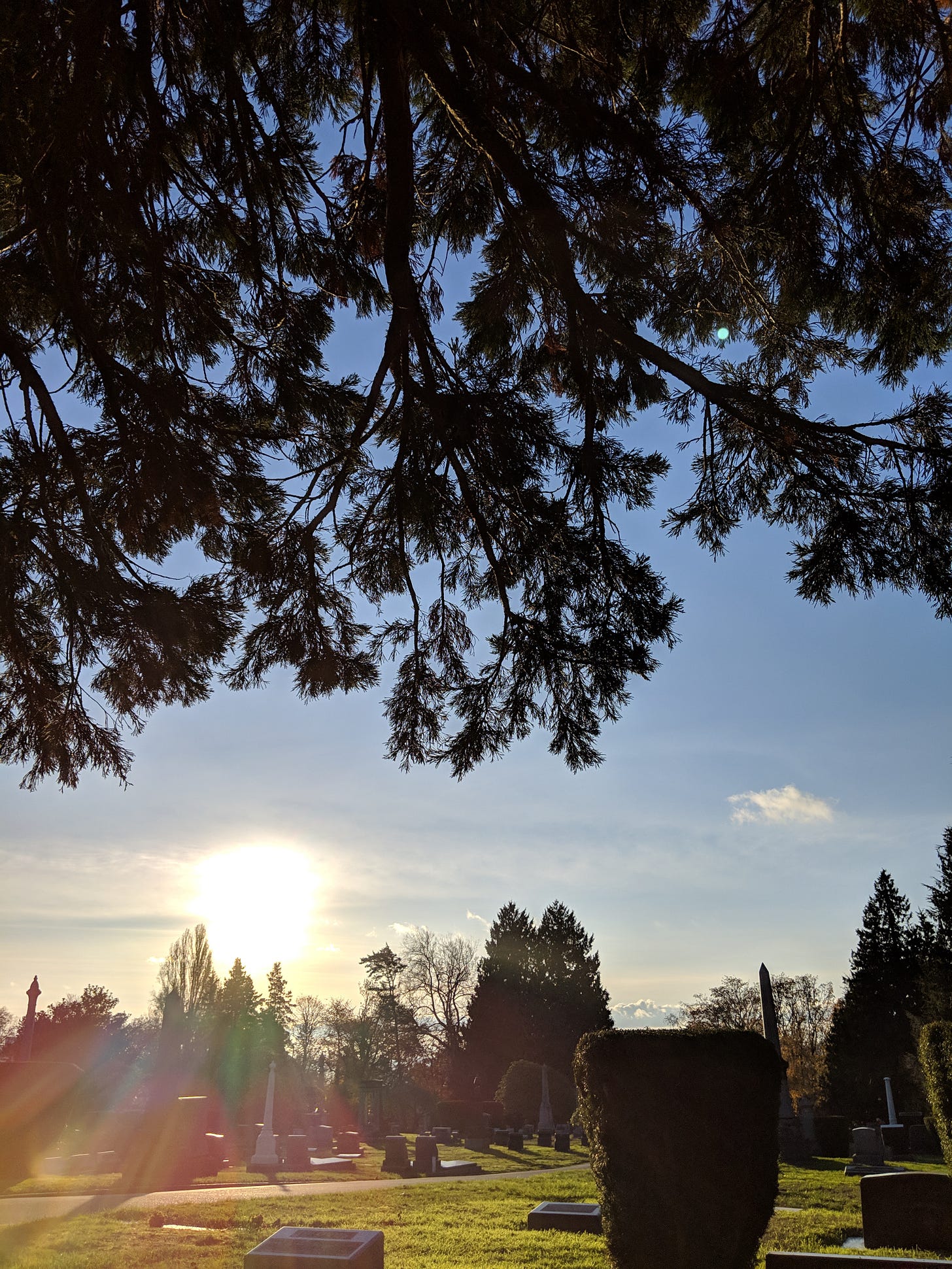
A couple of times a month now, I walk the three-mile loop north from my house, wind through the cemetery, and then back south.
Sometimes it’s quiet and contemplative, sometimes I bring a loved one and we talk the whole way, sometimes I’ve got loud music on my headphones and I dance with myself in one of Lakeview’s back corners.
Sometimes I bike through the cemetery with my son — although I recently saw a sign that said bikes aren’t allowed, so maybe I won’t do that anymore.
Sometimes, during the summer, I bring a book and a blanket and I stretch out with my dead friends and practice.
Mostly, I go to be awake and alive and aware.
I spend so much time on my phone and in my screens and up in my head, talking to people all over the world and in my imagination and the machinations and plans and strategies and algorithms and it’s incredibly difficult for me just to look around and notice things.
It’s hard to look away from the push notifications and just let the world pull you along.
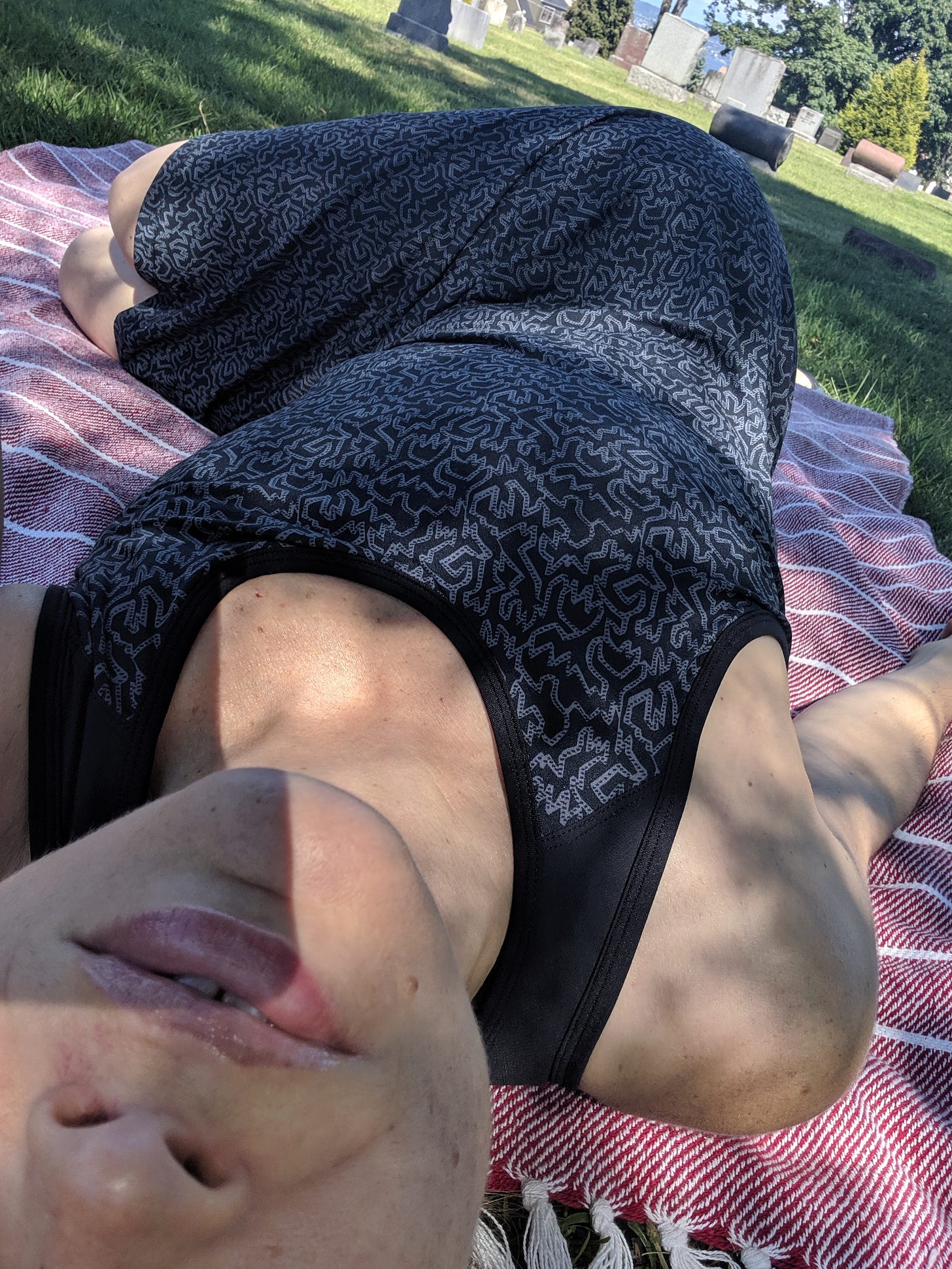
Sometimes on my walks, I even leave my phone at home.
…I KNOW! Lately, I’ve been trying to imagine my phone in my hand as a strong cocktail — do I really need to take this cocktail on a walk with me? Yikes. Do I really need to have this cocktail in my hand while I’m hugging my son? Eep. Is 7am really a good time for a cocktail? Barf.
So I leave my phone at home, and I leave my house and turn north and walk the treelined streets or dumpster-lined alleys and try to notice things.
I live in this neighborhood, in this present plane of existence.
I can notice it! I can notice the trash stuck in the grass, the stalled out townhome development, the schizophrenic young man rocking on the sidewalk in front of the pot shop. Ah, so.
After the hustle and bustle of my dense urban neighborhood, the cemetery is wonderfully quiet. I mean sure, there’s the small, steady stream of visitors to see the Lee graves, but the rest of Lakeview’s sloping hills and meandering drives are generally empty.
I like to read the headstones and imagine everyone’s stories. Sometimes I sit and cry with particularly sad stories (the parents who lost six children, the WWII Japanese American soldiers, the unmarked graves).
Sometimes I lay down on the grass and imagine that, if time is an illusion, in this moment, all the folks who are buried in the cemetery are all laughing together and then coming simultaneously.
Midlife: when your thoughts turn to giggling cemetery orgies!
Midlife: when crying at the grave of someone you didn’t know, feels entirely appropriate!
Midlife: when rainbow-wearing old ravers go goth.
Midlife: when my Enneagram 3w4 starts to lean real hard into that beautifully tragic four-wing!
I have a few favorite dead friends I like to visit, especially Grandma Dora here, who I’m convinced had a raunchy sense of humor because LOOK AT HER TREE’S BUTTHOLE!
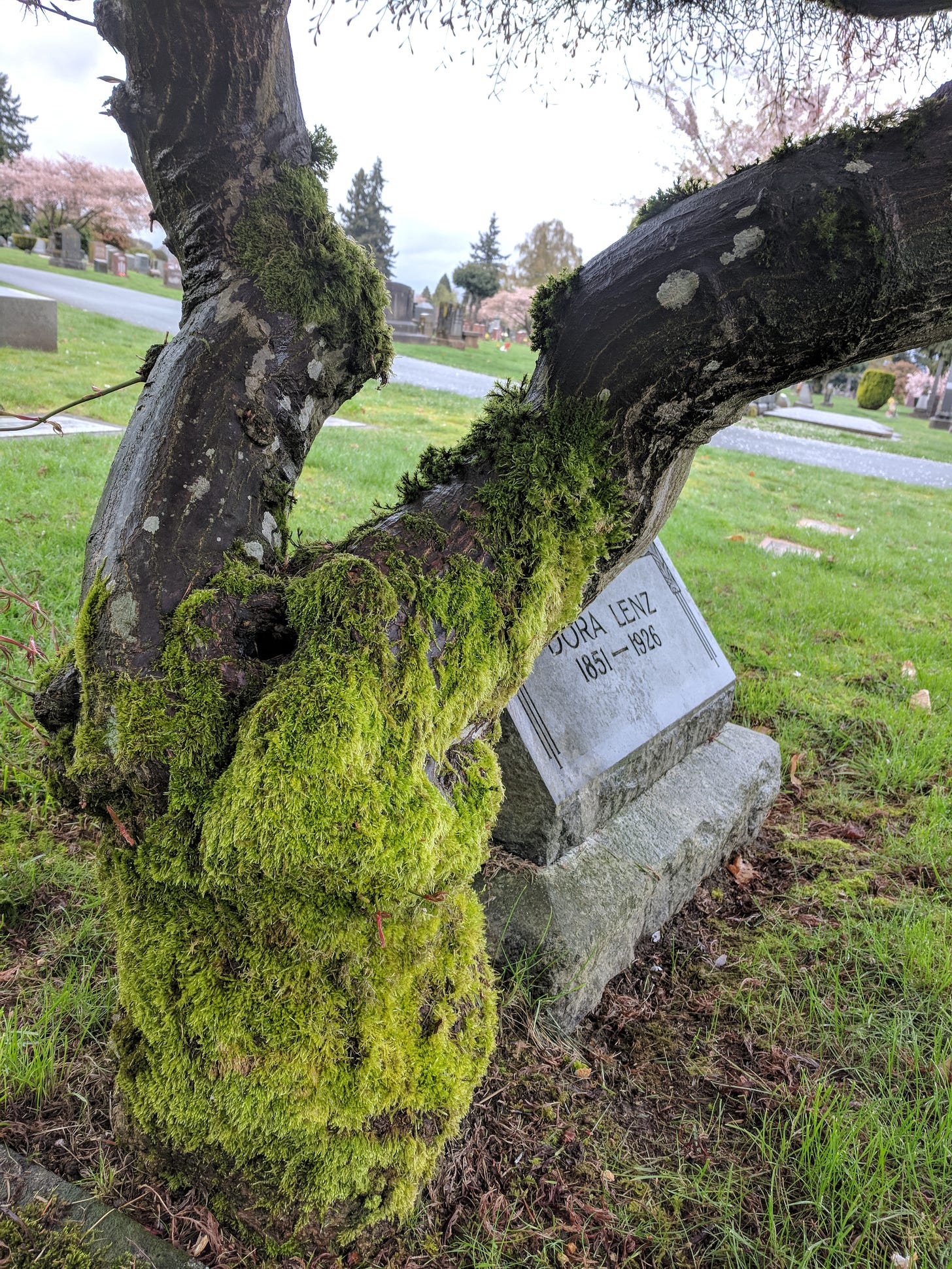
CHAPTER 2: The first exhumation
On one of my walks through the cemetery last summer, I turned off the road that winds through Lakeview and ventured into the gravestones in the far northwestern corner.
Wandering down the sloping hill toward the quietest corner of the cemetery, I wove between the gravestones like a garden. I admired them as I walked by, reading names like I was sniffing flowers. So many stories to smell!
Glancing up from my grave garden revery, I noticed that the chainlink fence at the bottom of the sloping corner of the cemetery was peeled back a bit, creating a space just big enough for a person to step through.
When I wandered further down the hill to investigate, I found a small trail leading from the opened chainlink. The light path led south, tracing along the outside western edge of the cemetery.
Huh. On all my walks, I’d never noticed that before.
I decided to slip through the fence and follow the trail. It was late summer, late afternoon and I’d left my phone at home. My son was with his father for the weekend, and I was gently stoned, and I had nowhere to be. No plans and no people were waiting for me. This kind of day used to fill me with panicked existential agoraphobia, but now it’s my favorite.
The trail traced along a steep, eroding slope above a brick retaining wall, which leaned maybe 10 feet above the sidewalk of a Capitol Hill back-street. The area between the cemetery fence and the retaining wall was lined with mature deciduous trees, their roots doing their best to hold the hill from pushing the strained brick wall from toppling onto the sidewalk below.

If you looked at the scene in geological time, you could see that this muddy, wet, grave-filled hillside was slowly sluicing its way downhill, gravity pulling the whole massive pile of soil ever onward, down the western slope of Capitol Hill toward the sunset.
I picked my way along the slope between the fence and the retaining wall, watching my footing closely to avoid tripping over the tree roots. I stepped over bits of trash stuck in the leaves, noticing shards of broken glass and candy wrappers and an old bottle and some more glass and…
…That’s weird. Why was there so much broken glass back here?
A few steps later, another glint caught my eye, this time peeking out under a tree root. I squatted down to investigate.
It was a mason jar, sticking out of the soil between the roots. Curious and stoned, I started digging around the jar, first with the toes of my Adidas, and then with my fingers.
I was delicate at first, but got more aggressive once I surrendered to the reality that my hands were going to get dirty.
A Ball jar emerged from the dirt. Whole, and unbroken, cradled in the roots of the tree.
Fucking cool!!
I looked up from my prize, glancing back at the path where I’d been walking, looking back at all that trash I’d stepped over.
Suddenly, I could see that the soil was brimming with glass and ceramics. Sure there was legit trash like cans and wrappers, but there were also the lips of bottles, the edges of jars, old flower pots, bits of broken vases.
Immediately, I understood what this was. These were decades of grave flower containers.
The containers that held flowers left on graves had been rolling down this hill for a hundred years. Lazy groundskeepers had probably tossed trash over the fence many times. Jars, bottles, vases, and flower pots had all rolled down the slope, and settled here, cradled in the arms of the roots.

I tried looking at the hill with different eyes, eyes with a time signature measured in centuries instead of seasons. I could see — no, I could feel how the slope was a slow, controlled mudslide, working its way down the western side of Capitol Hill.
It might take hundreds of years to get there, but entropy says all hills are heading toward all valleys, and so here we go! I could feel myself in the consciousness of the hill and feel its truth: I’ve got places to be, dammit!
(I am so down with panpsychism!)
The roots of the trees along the retaining wall were a part of the story, holding the jars and bottles and other containers safe in their hard fingers, through years of rain and sun and numerous human neighbors walking on them. As the slope’s slow journey down the hill continued, however, the jars were emerging — blossoming like little glinting petals from the soil behind my gravestone garden.
I was enthralled, and spent half an hour digging up first the Ball jar, and then what appeared to be a small but sturdy juice glass.
The path only goes for a half block, and then I scrabbled down an ivy-covered embankment to the corner of 11th & East Blain to head home.
I felt self-conscious, walking down the sidewalk in front of million-dollar homes, clutching two filthy old jars I’d just dug out of their graves. But I smiled at my neighbors as they passed, and radiated a vibe of “there is nothing at all odd about a middle-aged woman walking down the street double-fisting dirt-crusted glassware — these are not the droids you’re looking for.”
My walk home took me through Volunteer Park, where I randomly stumbled across a chamber music performance at the amphitheater! I’m not really into chamber music, but I had nowhere to be, so I sat down and enjoyed it.
My body felt, patient. The sensation was of being in precisely the right place at the right time.
There was nowhere else to be.
CHAPTER 3: Drinking death
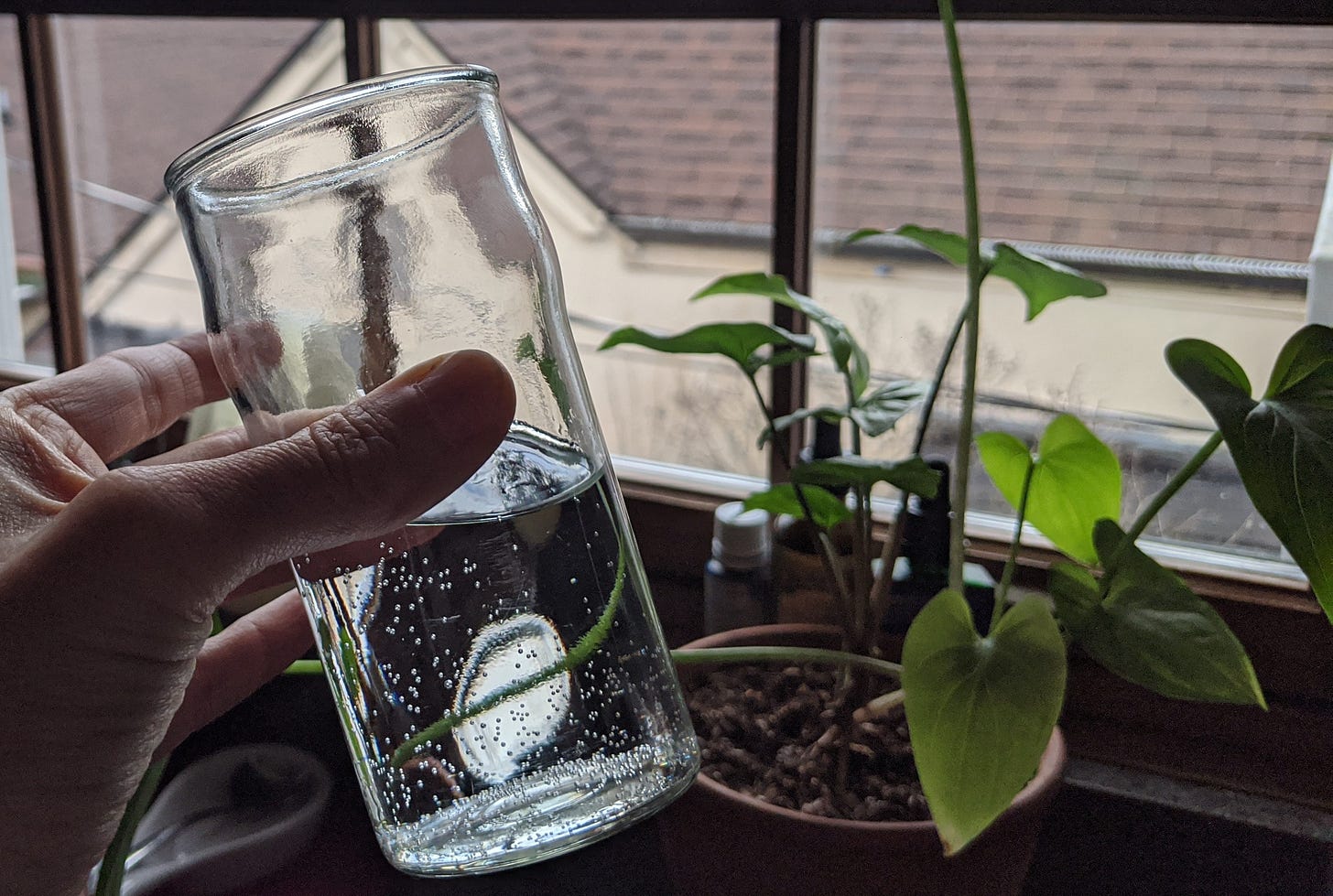
I got home that evening and got to work washing out my ground-score glasses in the kitchen.
As I stood at the sink, the water running muddy over my hands, I considered for a moment what I was doing. I’d just exhumed glass from behind a graveyard. The situation was macabre and kind of dark. I should be intentional about what I’m doing here, before I go thoughtlessly playing around with this energy I’d brought into my home.
I mean, was I going to drink out of this glass?
I lifted the glass up in my hands, letting the light from the window shine through it. It had cleaned up nicely, all the dirt washing off with relative ease. The glass was in excellent condition and didn’t feel that old, maybe the same age as me? It felt like it had served orange juice in the 1970s, in a mustard-colored breakfast nook in a split-level Brady Bunch kind of house.
The glass was physically clean (and honestly, I’m not worried about soil in my water — better dirt than plastic, know’msayin’?), but what story would I be telling when I drank from this glass?
What vibe was I was bringing into my scene, man!?
This was a container used for flowers on a gravestone. Was I drinking death? Was I filling my body with decay and rot, inviting in the agony of unresolved ghosts? Was this a grief chalice?
…Cool story bro, but that’s not my story. I don’t write dystopia — that’s my boyfriend’s jam. It’s just not my genre, you know? No, my mind didn’t go dark. My mind went where it usually goes, which is interpersonal relationship and conversations and social dynamics.
Someone had filled this glass with water and flowers, and then they’d taken the time to bring it to Lakeview and place it on a grave.
Someone alive filled this glass with love and life, and then they’d taken the time to bring it to Lakeview… to have a conversation with someone dead.
The conversation might have been, “I love you, and I miss you.” The conversation might be, “I’m so grateful for all you did for me.” The conversation might have one been of admiration, or obligation, or even anger or animosity (You always hated peonies, you asshole! Not much you can do about it now, huh?!).
It wasn’t my place to know the content of the conversation.
But regardless of content, all conversation is a form of attention. And all attention is a form of love. What you pay attention to, grows. Positive or negative, attention doesn’t care. As I’ve said for years, attention is currency. Attention is love. (The opposite of love isn’t hate — it’s disinterest.)
The way I saw it, this glass was a conversation.
The way I saw it, this glass was a love story.
I had exhumed a love story, and now I was going to drink from it. I rolled the story around in my mind like a smooth white marble.
…I’M IN!! I like that story.
My intention set; the situation felt all good. I told this glass what I saw in it and what I wanted from it. The glass shone its consent, and it was so. Hey, Love Story Glass! Welcome to my home! I love you! Wanna makeout? Here, I’ll put my mouth all over you so you can enjoy the attention, and we’ll make our own love story together!
I put the glass into the cabinet with all the other beloved glasses and mugs, and turned my attention to the Ball jar.
The jar was a worn pale blue, and felt old. Some quick googling informed me that it was from somewhere between 1910 and 1923. Cool! I’m not big on antiques, but I’m into a good century-old love story unearthed from the roots of trees.
This was a talisman I wanted in my home.
I filled the jar with water, popped some greens in it, and set it on a table.
Mission accomplished.

CHAPTER 4: The old hobos
I’ve gone back to the retaining wall several times, but last month I went back with Ellen, a bff/ex-gf of mine. Ellen’s lived on Capitol Hill since the mid-’90s like me, and we like to go on spontaneous neighborhood walks, winding through the hidden alleys as we dissect our lives and creative work and career challenges and self-inflicted interpersonal dramas.
I’d told Ellen about my summer ground-scores, and she’d mentioned noticing a sign on the north side of the cemetery — the retaining was being replaced, and a bunch of the old trees were getting taken out.
“It sounds like they tried everything they could to save the trees,” she said. “But there’s just not much to be done.”
“It makes sense,” I said. “Those trees are precarious, and the houses across the street are expensive. The wall looks like it’s at a weird angle.”
“The sign said that construction would be starting summer of 2019,” Ellen said, smirking because things were clearly running behind.
“The clock is ticking!” I shouted. “We should bring trowels!”
But then we went to brunch instead, trowels forgotten.
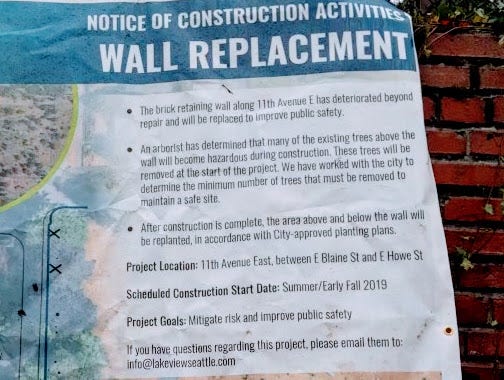
It was a cold Saturday, and although it wasn’t currently raining, a heavy rainstorm had just passed through Seattle. After brunch, we decided to go for a long walk to check out the wall.
I mean, how long is the wall even going to be there? You can bet that no-one’s going to be doing 20th-century archeological digs when they take out those trees! Might as well go exhume some love stories while we can, right?
We approached the wall from the street, clambering up the ivy slope toward the cemetery. The groundskeepers had recently tended the retaining wall area, and the soil was raked free of leaves.
The earth was extra exposed.
Again, the tree roots spread out their wares, like nature’s chthonic marketplace.

Ellen dug at a shard with a stick, while I poked around in the roots with my fingers. The earth was wet and cold, but not frozen.
This time, I dug up a bottle, its lid rusted tight to the neck.
Ellen and I assessed the bottle.
“Look at the cool grape decorations!” I said, turning the jar on its head and rubbing my fingers across the mud. “The bottom says Washington Wine Counsel — so I guess this is a wine bottle?”
“…shaped like a hip flask?!” Ellen laughed. “You can bet that was some shitty wine!”
“Totally,” I said, imagining an old wino slipping a bottle of sweet fortified wine into his trouser pocket, and heading to the cemetery to go get blotto in peace.
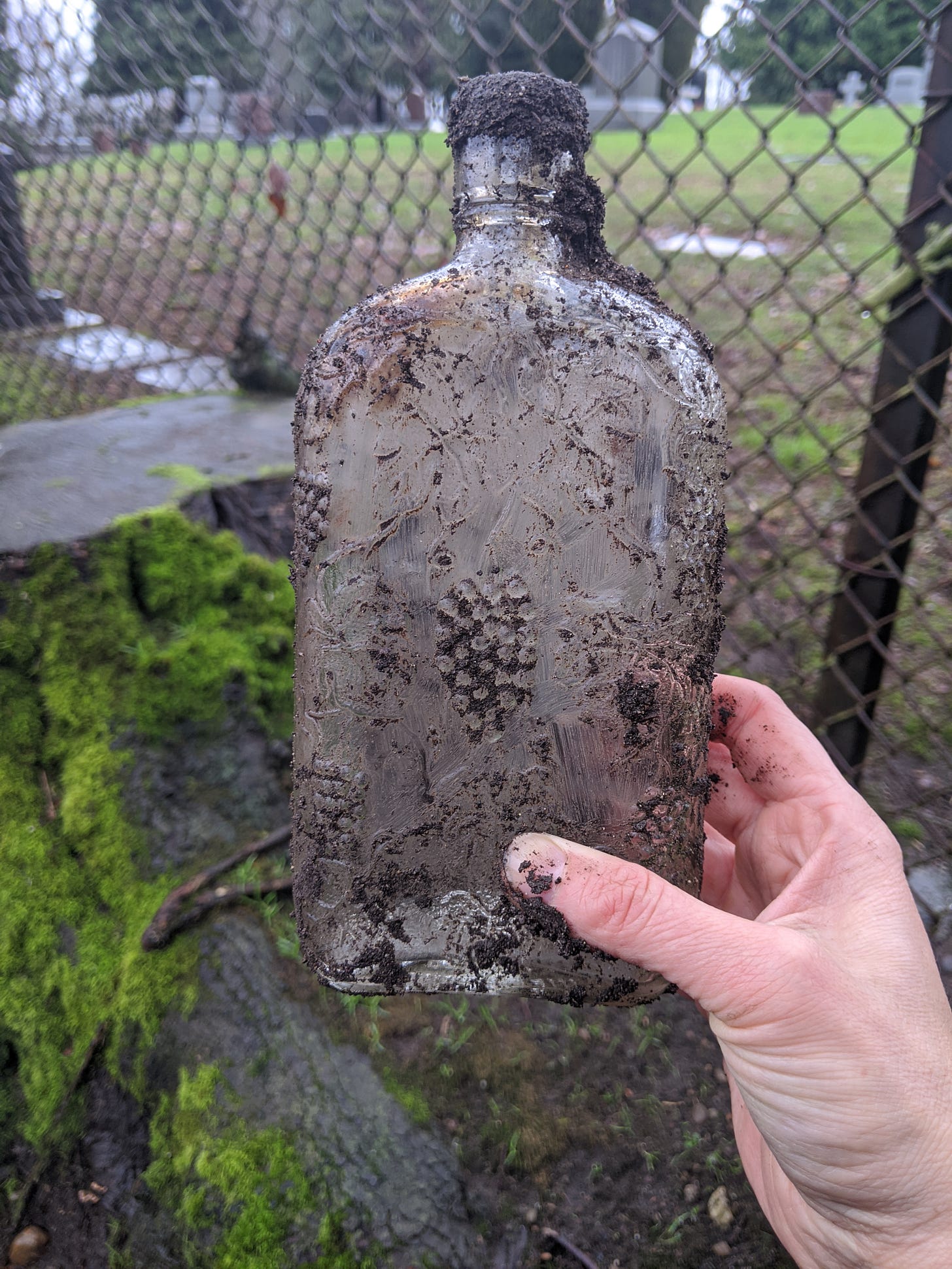
Ellen and I slipped through the fence into Lakeview, and I tucked the bottle under my arm, smearing my coat with mud. We washed our hands in rainwater collected mausoleum plaques.
My nails were crusted black with soil, but I did the best I could to rinse them, sliding my wet fingers back in my warm coat pockets for the walk home.
I rinsed the bottle off in my kitchen sink, welcoming it to my home, and then set it on my table.
I waited for the bottle to tell me what it wanted to do.
A couple of days later, the bottle announced its plan: this old hobo of a bottle wanted me to bring it home for Christmas, and introduce it to my father.
An old dirty bottle with a lid still rusted to its neck might sound like an odd gift, but if you know my dad, you know it’s perfect.
My father’s a former professor turned city bureaucrat, a longtime Buddhist who retired a decade ago to focus on his poetry. Dad’s a boomer iconoclast who loved James Brown in the 50s, watched Jim Morrison almost burn down a music festival stage in the ‘60s. Dad spent the ‘70s getting his Ph.D. and becoming a “back to the land” hippy, complete with hand-building a log cabin after reading a couple of manuals about the subject. I’m pretty sure he’s a 5w4, and he writes poems about Zen and his prostate.
Also, my family is known for unusual gifts. There are family legends about my mother giving everyone “rocks and sticks” for Christmas one year. She’d made sand candles at the beach, decorated with all sorts of found organic materials, but really, they sorta did look like rocks and sticks — there just happened to be a wick in there, too. (Trivia: these kinds of things sell for $35 on Etsy now. Mom was 40 years ahead of her time!)
“It’s not rocks and sticks,” I said on Christmas day, as my father unwrapped the dirty bottle and looked at me, a little baffled.
Then I told him the story, about the summer walk and my discovery, and Ellen’s and my recent visit to the doomed trees and retaining wall.
My dad likes a good story, so he was super into it.
He’s also a curious nerd like me, so after he took the bottle home, he washed it and researched it. The Washington Wine Council was founded in 1938, but became the Washington Wine and Grape Growers sometime in the ‘50s, so the bottle probably originated sometime in the 1940s — just like my dad! Similar bottles are listed for $100 on eBay.
My dad replaced the lid and filled the bottle with brandy.
I’m pretty sure the 70-something hobo bottle is deeply contented in its new home, happily shacked up with its 70-something poet friend. I imagine them sharing nips of brandy, laughing over old stories.
CHAPTER 5: The moral of the story
I know how this goes… Some of you just read this and thought to yourselves, “How come I never find cool things by a cemetery?! Interesting shit like this never happens to me!”
This is the same little voice that whispers at some of you, “I can’t start a daily movement practice because I don’t have the right headphones.”
That little voice is a liar! It’s a loving little liar trying to keep you safe (aww, thanks, little voice!), but it’s a liar.
This is a story about wandering through a neighborhood and noticing things. Noticing is free!
This is a story about gaining comfort with loneliness and liminality and not knowing where you’re going. This is a story about heading out any way to wonder at the wander — even if you’re a person who likes a map and a plan.
This is about just allowing things to unfold.
This is a story about staying present with where you are emotionally (even when it’s uncomfortable, awkward, maudlin midlife ennui) and feeling it all the way knowing it will change. It’s about maybe recognizing some unexpected joys in the discomforts.
This is a story about stepping away from the screens, going out into your most immediate, very close little world, and taking the time to focus your attention on the small things you usually walk by and step over.
It’s just a story about seeing familiar places differently.
It’s just a story about noticing.
It’s a story about love.
All of these stories are completely accessible to you — today!
So many of us spend so much time ignoring our physical worlds, stuck in our screens, our minds off in digital lands far and wide. Our bodies just sit there ignored, sitting in our ignored neighborhoods.
If this story inspires you, I invite you to put down the device you’re staring at right now, put on your shoes, grab your keys, step outside, and go notice where you are.
Peek into the back alleys and spend some time with the ants in a crack by a dumpster. Go investigate the grass in an empty lot. Be safe, but go find a hidden corner behind a strip mall and see what’s oozing out of the asphalt.
The only task is just noticing, and then observing the stories that come up — judgment? admonishment? where is that hill going? where are you going? Try to observe the subtle sensations in your body — ew, that loogie on the sidewalk turned my stomach, but that dead leaf has a remarkable symmetry to it. Can you love it?
The experience of exhuming love stories in your neighborhood is deeply, profoundly accessible to you.
Go see what you can dig up this weekend.
…And then tell me what you find!


I needed to read this today, and on so many levels. Thank you.
You’re welcome! I’m so glad you enjoyed it. <3
My current writing doesn't really fit in with Offbeat Home & Life (too long! too dense!), so it doesn't make sense for me to share it here... but if you enjoyed this, I hope I'll see you over at The Afterglow.
I love this. I’m a big believer that adventure starts with observation. A funny-looking crack in a wall, turning down a different path, the bark on a tree, it’s all fair game.
Agreed! I feel like that kind of observation is part of beginner’s mind practice … it’s especially challenging when you’re in a place that’s very familiar! Lots of us use travel to help us get out of my mental ruts, but you can have an adventure at home if you just shift your brain to REALLY observe where you are, even if you’ve been there a million times before!
Why are more people not into recreational cemetery walk? This was a very interesting read and you are a braver woman than I to bring the bottles home (even though I would love to!). I am still rather nervous of attached woo. Sounds like you have attuned your energy-radar better than I have!
Dude, the recreational cemetery walk is the best. So much to learn, so many stories to honor, so much peace and quiet, so many happy tears!
As for the attached woo… I really see grief and love as the same sphere. For me, they’re not even two sides of the same coin…. love & loss are both parts of a three-dimensional sphere, and I see honoring one aspect as honoring all aspects. So sure: the bottles have some grief and death and loss attached, just as they have some joy and birth and love attached.
Yeah, I can definitely see that my thinking is dichotomous here. A very black/white, good/evil type of paradigm that comes from my specific type of Christian background. Despite seeing this, I still seem stuck and unable to get past it. Clearly still have some work to do!!